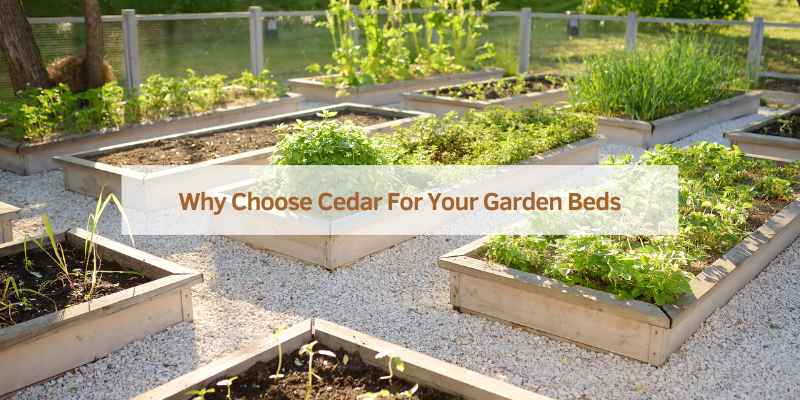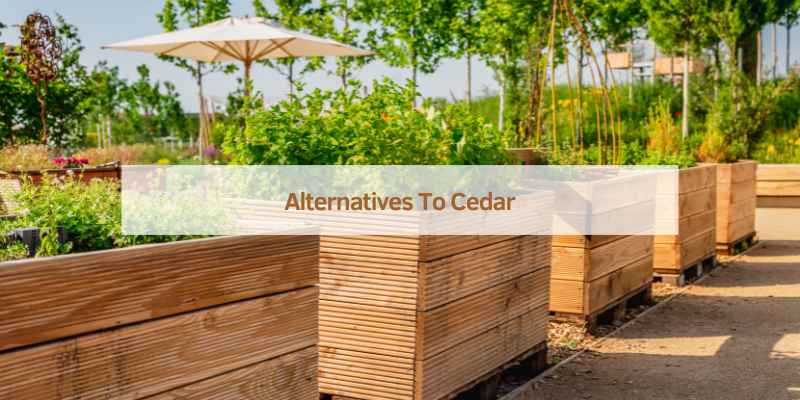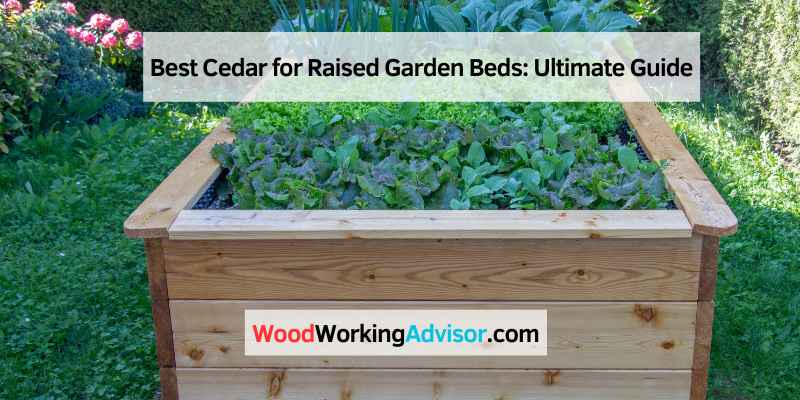The best cedar for raised garden beds is Eastern red cedar (Juniperus virginiana) as it offers natural resistance to rot and insects, making it a durable choice that will last for years even when in contact with soil. Cedar lumber is often used in constructing raised beds due to its excellent properties.
It is important to choose the right type of wood for raised garden beds to ensure longevity and optimal performance. Cedar is a popular choice among gardeners for its durability and natural resistance to decay. Other suitable options include cypress, hemlock, juniper, redwood, and pine.
It is recommended to avoid using pressure-treated wood or any wood that has been treated with chemicals in raised garden beds to ensure the safety of plants and humans. Instead, opt for untreated wood, specifically cedar or redwood, for making raised beds.
Why Choose Cedar For Your Garden Beds
When it comes to selecting the best wood for your raised garden beds, cedar is a top choice among gardeners. Its natural durability and insect resistance qualities make it an ideal material for constructing garden beds that will withstand the test of time. Let’s delve into the reasons why cedar is the best option for your garden beds.
Natural Durability Against Rot
Cedar lumber is renowned for its natural resistance to rot. The high levels of natural oils and resins present in cedar wood act as a protective barrier against moisture, preventing the wood from decaying over time. This means that your cedar garden beds will remain structurally sound and visually appealing for years to come, even when in direct contact with the soil.
Insect Resistance Qualities
Another advantage of cedar wood is its inherent resistance to insects. Cedar contains natural compounds that repel pests, including termites, ants, and beetles. This means that your garden beds are less likely to be invaded by damaging insects, ensuring the health and longevity of your plants.
Moreover, using cedar for your garden beds eliminates the need for chemical insecticides, promoting a healthier and more environmentally-friendly gardening experience.
In addition to its resistance against rot and insects, cedar wood also boasts other beneficial properties. It has a pleasant aroma that acts as a natural deterrent to certain pests, such as moths and mosquitoes. Furthermore, cedar wood is known for its natural insulation properties, helping to regulate the soil temperature within the garden beds.
In conclusion, choosing cedar for your garden beds is a wise decision due to its natural durability against rot and its insect resistance qualities. By opting for cedar, you can ensure the longevity of your garden beds while promoting a healthier and more sustainable gardening environment.

Types Of Cedar For Garden Beds
Cedar lumber is a popular choice for constructing raised garden beds due to its natural resistance to rot and insects.
Eastern Red Cedar Qualities
Eastern Red Cedar (Juniperus virginiana) is highly rot-resistant and can withstand soil contact for many years.
Comparing Western Red Cedar
Western Red Cedar offers similar durability and insect resistance to Eastern Red Cedar, making it a suitable choice for garden beds.
Safety Concerns With Cedar And Pressure Treatment
When considering the best wood for raised garden beds, cedar is often a popular choice due to its natural resistance to rot and insects. However, there are safety concerns regarding the use of cedar and pressure-treated wood in garden beds. Understanding the implications of pressure treatment and determining the safety of cedar for edible gardens is crucial for making informed decisions when constructing raised beds.
Understanding Pressure-treated Wood
Pressure-treated wood is a type of lumber that has been infused with preservatives to protect it from decay and insect damage. The treatment process involves placing the wood in a pressure chamber and forcing a preservative solution into the wood fibers. This treatment extends the lifespan of the wood, making it suitable for outdoor applications.
Is Cedar Safe For Edible Gardens?
One of the primary concerns regarding cedar in edible gardens is the potential leaching of chemical compounds from the wood into the soil and subsequently into the plants. While cedar is naturally resistant to decay and insect infestation, it is essential to ensure that the type of cedar used is safe for growing edible plants. Additionally, the use of pressure-treated cedar raises questions about the safety of the chemicals in the wood and their impact on the soil and plants.
The Longevity Of Cedar In Garden Beds
When considering the best wood for raised garden beds, the longevity of cedar is a crucial factor to take into account. Cedar is widely favored for its natural resistance to rot and insects, making it an ideal choice for garden bed construction. Let’s delve into the expected lifespan of cedar wood and explore some maintenance tips for ensuring its durability over time.
Expected Lifespan Of Cedar Wood
Cedar wood is renowned for its exceptional durability, with an expected lifespan ranging from 10 to 20 years when used in garden beds. Its natural resistance to decay and insect infestations contributes to its longevity, providing gardeners with long-term structural integrity and stability.
Maintenance Tips For Longer Durability
To prolong the lifespan of cedar in garden beds, it is essential to implement maintenance practices that optimize its durability. Here are some maintenance tips to consider:
- Regularly inspect the wood for any signs of wear, damage, or insect activity.
- Apply a protective finish, such as a water-based sealant or oil, to shield the wood from moisture and UV exposure.
- Replace any deteriorating or rotted cedar boards promptly to maintain the structural integrity of the garden bed.
- Avoid exposing the cedar to prolonged contact with damp soil or standing water, as this can expedite decay.
- Consider lining the interior of the bed with a barrier, such as heavy-duty plastic, to create an additional shield against moisture.
Cost Considerations
When deciding on the best cedar for your raised garden beds, it’s essential to consider the cost implications. Understanding the pricing of different cedar varieties and how to balance quality with your budget is crucial for making the right choice.
Pricing Cedar Varieties
Comparing the prices of various cedar options can help you make an informed decision. Here are some common cedar varieties and their average prices:
| Cedar Type | Average Price |
|---|---|
| Eastern Red Cedar | $70.48 |
| Juniper Cedar | $101.95 – $120 (15% OFF) |
| Redwood Cedar | $135.00 |
Balancing Quality With Budget
When choosing cedar for your raised garden beds, it’s important to strike a balance between quality and budget constraints. Consider the following tips to ensure you get the best value for your money:
- Research different cedar varieties and their properties before making a purchase.
- Compare prices from various suppliers to find the most cost-effective option.
- Look for discounts or sales to save money on high-quality cedar.
- Consider the long-term benefits of investing in durable cedar that requires minimal maintenance.
By weighing the pricing of cedar varieties and prioritizing quality within your budget, you can create beautiful and long-lasting raised garden beds without breaking the bank.
Eco-friendly Aspects Of Cedar
Cedar is the ideal choice for raised garden beds due to its natural resistance to rot and insects. Eastern red cedar, specifically, is highly durable and can last for years, even when in direct contact with soil. This eco-friendly aspect makes cedar a top pick for sustainable gardening solutions.
Sustainability Of Cedar Wood
Cedar wood is a popular choice for raised garden beds due to its durability, natural resistance to rot and insects, and eco-friendly aspects. Cedar is a sustainable wood option because it is a fast-growing tree species that can be harvested in a responsible manner without depleting natural resources. Moreover, cedar wood is a renewable resource that can be regrown and replanted, making it an ideal choice for environmentally conscious gardeners.
Certifications And Eco Labels
Certifications and eco labels are important indicators of the sustainability and eco-friendliness of cedar wood products. Look for cedar wood products that are certified by reputable organizations such as the Forest Stewardship Council (FSC) or the Sustainable Forestry Initiative (SFI). These certifications ensure that the cedar wood used in the product is harvested and produced in a sustainable and responsible manner, without causing harm to the environment or the local communities.
In addition to certifications, eco labels such as the Green Seal or the EcoLogo can also help identify eco-friendly cedar wood products. These labels indicate that the product has undergone rigorous testing and evaluation to ensure that it meets certain environmental standards and criteria.
When choosing cedar wood for your raised garden beds, consider the sustainability of the wood and look for certifications and eco labels to ensure that you are making an eco-friendly choice. By using sustainable and eco-friendly cedar wood, you can create a healthy and thriving garden while also protecting the environment.
Designing With Cedar Raised Beds
When it comes to designing with cedar raised beds, the aesthetic appeal of cedar, as well as the ability to customize bed sizes and shapes, makes it a popular choice among gardeners. Let’s explore the design aspects of cedar raised beds in more detail.
Aesthetic Appeal Of Cedar
Cedar is prized for its natural beauty and rustic charm, adding a touch of elegance to any garden setting. The rich color variations and distinctive grain patterns of cedar wood create visually appealing raised beds that seamlessly blend with the natural landscape.
Customizing Bed Sizes And Shapes
One of the key advantages of using cedar for raised beds is the flexibility it offers in terms of customization. Gardeners can easily tailor the dimensions and shapes of their raised beds to suit their specific gardening needs and space constraints. Whether it’s a rectangular, square, or L-shaped design, cedar wood can be effortlessly shaped to accommodate various layouts.
Avoiding Common Mistakes
Selecting The Right Cedar
When choosing cedar for your raised garden beds, it’s crucial to select the right type of cedar that offers natural resistance to rot and insects. Eastern red cedar, also known as Juniperus virginiana, is highly recommended due to its exceptional rot resistance, ensuring longevity even in direct contact with soil. This type of cedar is a reliable choice for raised garden beds, providing durability and low maintenance.
Installation Tips To Prevent Rot
Proper installation is essential to prevent rot in cedar raised garden beds. To maximize the lifespan of your cedar beds, ensure adequate drainage by using a layer of gravel at the bottom. Additionally, consider lining the interior of the beds with a protective barrier such as landscaping fabric to minimize direct contact between the cedar and damp soil, reducing the risk of decay.
Where To Buy Cedar For Garden Beds
Looking to buy cedar for your raised garden beds? Consider Eastern red cedar (Juniperus virginiana) for its natural resistance to rot and insects, ensuring durability even in direct contact with soil. Check out local nurseries, garden centers, or online retailers for the best cedar options.
Cedar is one of the most popular choices for building raised garden beds due to its natural resistance to rot and insects. However, not all cedar is created equal, and it’s important to know where to buy high-quality cedar for your garden beds.
Local vs. Online Retailers
When it comes to buying cedar for your garden beds, you have two options: local retailers or online retailers. Local retailers such as Home Depot and Lowe’s offer a variety of cedar planks and boards that you can purchase in-store. This can be a great option if you want to see the wood in person before making a purchase. However, local retailers may have limited options and higher prices compared to online retailers.
Comparing Price Points
Online retailers such as Burpee Gardening and Eartheasy.com offer a wider selection of cedar planks and boards at competitive prices. These retailers often offer bulk pricing or discounts for larger orders, making them a great option for those looking to build multiple garden beds. Additionally, some online retailers offer free shipping, further reducing the overall cost.
It’s important to note that while treated wood and lumber may be cheaper, they may not be the best option for building raised garden beds. Treated wood contains chemicals that can leach into the soil and harm plants or even pose a health risk to those consuming the plants. Therefore, it’s best to stick with natural cedar for your garden beds.
In conclusion, when it comes to buying cedar for your raised garden beds, online retailers offer a wider selection and competitive prices, while local retailers may offer the benefit of seeing the wood in person. Always choose natural cedar over treated wood or lumber for the health of your plants and yourself.
Alternatives To Cedar
When considering alternatives to cedar for raised garden beds, it’s important to explore various options that offer a balance of durability and cost-effectiveness. While cedar is a popular choice due to its natural resistance to rot and insects, there are other woods and materials that can also be considered for your gardening project.
Other Woods And Materials
When looking at alternatives to cedar, there are several other woods and materials that can be used for raised garden beds. Some options include:
- Redwood: Known for its durability and natural resistance to decay.
- Cypress: Offers similar benefits to cedar in terms of longevity and insect resistance.
- Hemlock: A cost-effective option that can be a good alternative to cedar.
- Pressure-treated lumber: Treated wood can provide durability at a lower cost.
Weighing Durability And Cost
When deciding on the best wood for your raised garden beds, it’s essential to weigh the factors of durability and cost. While cedar may be a top choice for its longevity and natural properties, other materials like redwood and cypress can offer similar benefits. Consider the lifespan of the wood, maintenance requirements, and upfront costs before making your final decision.

Frequently Asked Questions
What Kind Of Cedar To Use For Raised Beds?
Choose Eastern red cedar for raised beds as it’s highly rot-resistant and durable against insects.
What Is The Best Wood For Raised Garden Beds?
Cedar is the best wood for raised garden beds as it is naturally rot-resistant and offers protection against insects. It is recommended to use untreated cedar or redwood for making raised beds. Other suitable wood options include cypress, hemlock, juniper, and redwood.
Avoid using pressure-treated wood in garden beds.
Is Pressure Treated Cedar Safe For Raised Garden Beds?
Pressure treated cedar is not recommended for raised garden beds as it contains chemicals that can leach into the soil and harm plants. It is best to use untreated cedar or redwood for raised garden beds as they are naturally resistant to rot and insects.
These types of wood are safe for both adults and children.
What Wood Should Not Be Used In A Raised Garden Bed?
Avoid using pressure-treated wood in raised garden beds; opt for cedar or redwood for a safer option.
Conclusion
Choosing the right cedar for raised garden beds is crucial for longevity. Consider Eastern red cedar for its natural resistance to rot and insects. Ensure to use safe, untreated wood for a healthy gardening environment. Make an informed decision for sustainable and thriving raised beds.


